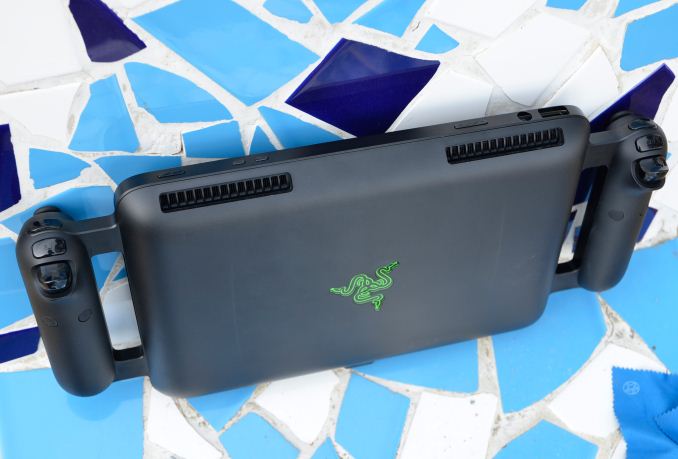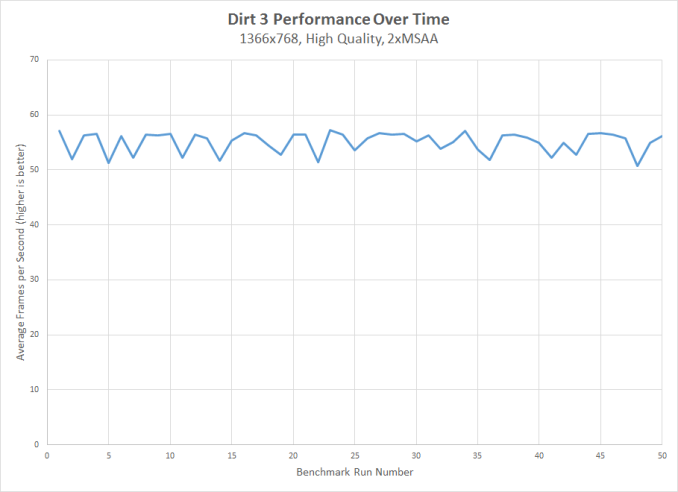The Razer Edge Review
by Vivek Gowri on March 28, 2013 11:00 AM EST- Posted in
- Tablets
- Mobile
- Razer
- Razer Edge
Thermals
The thermal story here is pretty interesting. Obviously, with a huge thermal envelope for such a small form factor, the first concern I had was for heat. Razer has a fair bit of experience shoving a lot of hardware in tight spaces, though with the Blade the problem construction was different. The Blade chassis is very thin, but has a lot of room in terms of footprint. The sheer amount of surface area top and bottom, as well as all the venting on the bottom and sides, help the Blade (especially the 2nd generation one) effectively cool itself even though there’s relatively little volume available.
The Edge, by comparison, has a tiny footprint and hence needs to be much thicker than competing tablets; it’s actually also thicker than the bottom casing of the Blade, so there’s that too. Airflow is extremely key here, since there’s very little surface area to let heat dissipate convectively. The heat pipe, too, is key, as tablets have far more orientations that need to be designed for when compared to notebooks. Orientation matters for heat pipes, as their effectiveness depends on how much working fluid can be transported from the condenser to the evaporator. Operating against gravity is always a losing proposition, and as such there’s an inverse correlation between transport capacity and operation against gravity (ie, as the angle of operation against gravity increases, the transport capacity of the heat pipes typically decrease.)
At some point in the future I’ll do a much more thorough article on how heat pipes and the cooling systems in mobile computers work, but for now this will have to suffice. The TL;DR version as pertinent to this article: if you have enough compute horsepower in a tablet to require active cooling, you’re in for a hell of a time. Tablets are much harder to cool actively than notebooks.
Which is why thermal performance was, for me at least, the major concern with the Edge prior to launch. The 0.8” thickness helped alleviate my fears somewhat, because that gets you a significant amount of volume to work with compared to something like the Surface Pro. Ivy Bridge ULV and Kepler are also pretty good as far as thermal performance goes, so I wasn’t concerned at all about how it would behave under light usage cases, particularly ones that didn’t have the GPU turning on. But when the system is stressed, what then?
To find out, I fired up my 100% system load test – Furmark 1080p and wPrime 1024M (4 threads) looping, which maxes CPU and GPU – and let it run for a sustained period of time. I saw GPU temps hit 85C with ease, while CPU got up to 95C. The GPU temperature stabilizes in the 87F region at 0.887V (the voltage at 500MHz). CPU temp stabilizes in the low 90s, which is interesting because we typically see CPU temperatures that are lower than the GPU temps. CPU power draw hovers around 14.7W when both cores are loaded. The Edge reaches thermal equilibrium before it starts throttling the GPU, which is a good sign.
I also ran my real-world gaming situation with the Dirt 3 benchmark, and like last time, ran it 50 times in a row, this time on high settings with 2xMSAA at 1366x768, my graphics setup of choice for playing the game when the Edge was plugged in. The results were pretty interesting – while average framerates stayed in the 52-56 fps range for a majority of the tests, the minimum framerate told a good bit of the story. There are three primary speeds and voltages the GPU runs at: the default 500MHz (0.887V), 570MHz (0.912V), and 405MHz (0.813V). In many of the runs in the 55-57fps range, the minimum framerate would be around 45-46fps, while some of the runs that had average fps on the low end (51-52fps), the minimum framerate would be below 40, sometimes as low as 35 fps. This happened every three or four runs, with consistency, with the GPU clocking down to the lower voltage performance state when necessary in order to maintain thermal equilibrium. At no point was there an extended period of throttling, which is why performance remained mostly constant for the roughly two and a half hours it took to go through 50 runs of the benchmark. That’s pretty impressive, considering the amount of thermal stress the GPU puts on a system of this size.












89 Comments
View All Comments
Blibbax - Thursday, March 28, 2013 - link
"would be awkward or impossible to play PC games are no longer so"Where can you use this that you couldn't use a similar sized laptop, though? This is what I don't get about tablets in general.
jamyryals - Thursday, March 28, 2013 - link
Many, many people disagree with you about tablets.freedom4556 - Thursday, March 28, 2013 - link
Think about it in terms of gaming though (as in, with a mouse or gamepad). Many, many people with tablets only play Angry Birds, Fruit Ninja, and Cut the Rope.A5 - Thursday, March 28, 2013 - link
That doesn't mean those are the only games on the platform. That's like saying PC gaming is worthless because most people only play The Sims or WoW.freedom4556 - Thursday, March 28, 2013 - link
That's not what I said, though. The original comment was "why a tablet when a laptop goes everywhere it does without the compromises?" The reply was many disagree with that (implying tablet sales were an indicator of gamers choosing tablets.) My reply was meant to say that real gaming wasn't happening on those tablets, and as such didn't indicate that gamers were ok with the compromises. I don't personally believe the the battery life, performance and cost are worth the "gaming tablet" concept, but then I don't like playing games on PC with the Xbox 360 controller. I prefer the wider range of motion and larger key count of a mouse+keyboard.Netscorer - Saturday, March 30, 2013 - link
His point is that tablets excel in touch-based games and activities. Once you start playing regular PC games that do not use touch, the whole advantage of a tablet compared to a laptop becomes iffy. Add enormous weight and short battery life and I, frankly, too do not see a point in this hybrid.VivekGowri - Friday, March 29, 2013 - link
Take a laptop - small, large, anything - and try to play an FPS or a racing game while riding the bus or subway. Or sit on your couch and try. It's somewhere between difficult and impossible to do, even if you use a touchpad and not an external mouse.The Edge works like a massive Gameboy Advance or PSP - just hold the controllers and go from there. It's closer to a portable console in experience than a notebook PC, even if it has PC silicon inside.
kyuu - Friday, March 29, 2013 - link
Plug in an Xbox controller, or use a wireless one. Heck, I believe you can connect a PS3 controller via bluetooth as well. I think you could play an FPS or racing game on a laptop fairly well that way.RoninX - Thursday, March 28, 2013 - link
Great review.Vivek, I have a Razer Edge Pro on pre-order, and I was wondering what you used to carry it around on airline flights. Is there a particular type of bag or case that works well to carry the Edge while docked with the gamepad? (Preferably one that's easy to pull out mid-flight.)
Thanks!
VivekGowri - Friday, March 29, 2013 - link
I just put it in my 17" notebook backpack (High Sierra Elite, $30 at Costco). You'll need at least a 15" backpack to fit it, the dimensions with the gamepad controller attached are roughly 15.9x7.7x1.3" - the width is about an inch and a half more than then MBP15, but only .75" more than the Dell XPS15z so your mileage may vary. 17" notebook bags hold it with ease though.